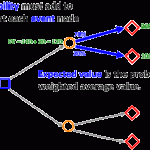 Everybody knows that there is some luck involved in poker. However, despite what some congressmen think, there are also plenty of things players can do to control their own destiny in poker. And this mainly comes from making plays with positive expected value. If expected value (EV) is a totally alien concept to you, then here is some info that might make it clear how important expected value is.
Everybody knows that there is some luck involved in poker. However, despite what some congressmen think, there are also plenty of things players can do to control their own destiny in poker. And this mainly comes from making plays with positive expected value. If expected value (EV) is a totally alien concept to you, then here is some info that might make it clear how important expected value is.
Expected Value Definition
The literal definition of expected value is how much money you stand to win or lose on an average poker play. Obviously the better you are at poker, the more positive your EV will be.
To put expected value into illustration, let’s say that you and another person flipped a coin for money. If the coin ends up heads, you would win $1; if the coin ends up tails, the other person would win $1. Since the odds of a coin flip landing on one particular side is 50%, your EV would be 0. However, let’s assume that you are now making $5 each time the coin ends up heads while the other person is only making $2 for tails. You are getting major +EV here while your coin-flipping opponent is getting -EV.
EV in Poker
Without getting into any major mathematics, let’s look at a quick example of a +EV play in poker. Assume that you’re holding 10s-Js on a board of 9s-8s-Kc, and your opponent accidentally flipped over their cards to reveal A-K after making a $10 raise leaving the pot at $60. They have top pair and are ahead at this point, but you also have both straight and flush chances.
There are 9 spades left in the deck along with 6 non-spade Q’s and 7’s that will make your hand. This gives you a 15 out of 46 chance (you’ve already seen 7 cards) or 3-1 odds of making your hand. Seeing as how you only have to contribute 14% of the pot (7-1) to call, you are getting amazing pot odds. So calling would be an example of positive expected value.